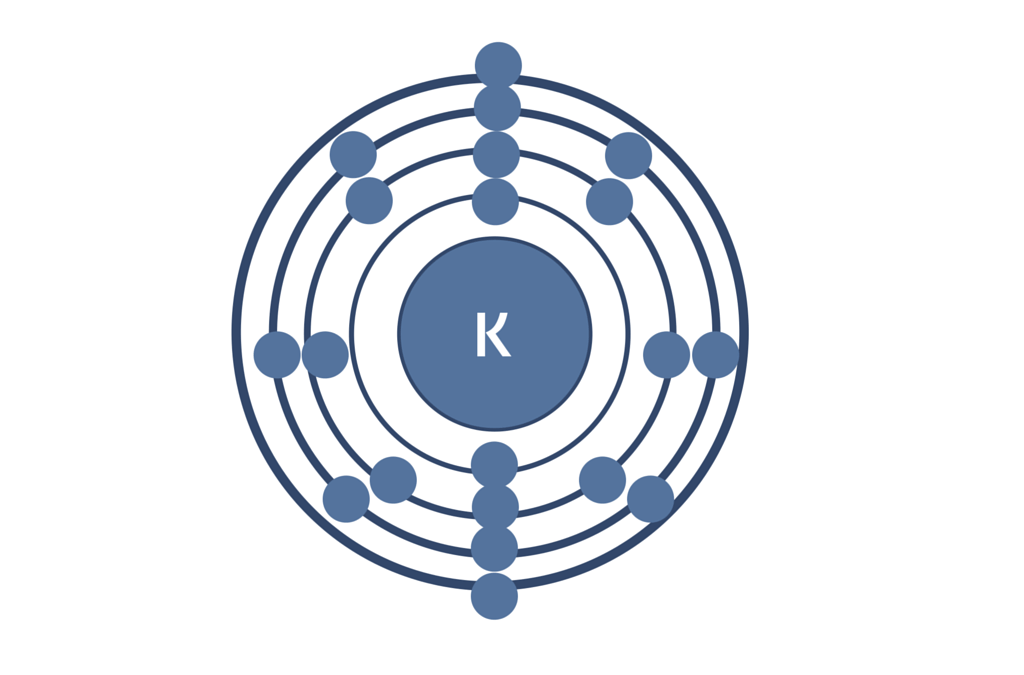
1) Potassium in aquaponics: commonly deficient and tricky to manage.
When it comes to interesting (and frustrating) nutrients in aquaponic systems, potassium takes the cake. Potassium is the most commonly deficient nutrient by far (9 out of 10 are a potassium deficiency). But that’s not all—potassium also has a complicated relationship with other nutrients in the system, which makes it tricky to manage.
Potassium is introduced to your system in the form of fish feed or supplements like potassium hydroxide or kelp meal concentrate. However, the potassium levels in most fish feeds aren’t adequate for both plants and fish.
This means that potassium is often deficient in aquaponic plants. This causes all sorts of problems.
2) Plants use potassium in 4 important ways
Potassium is a simple, soluble element, important for plants as well as animals. In fact, practically every living thing needs potassium to survive.
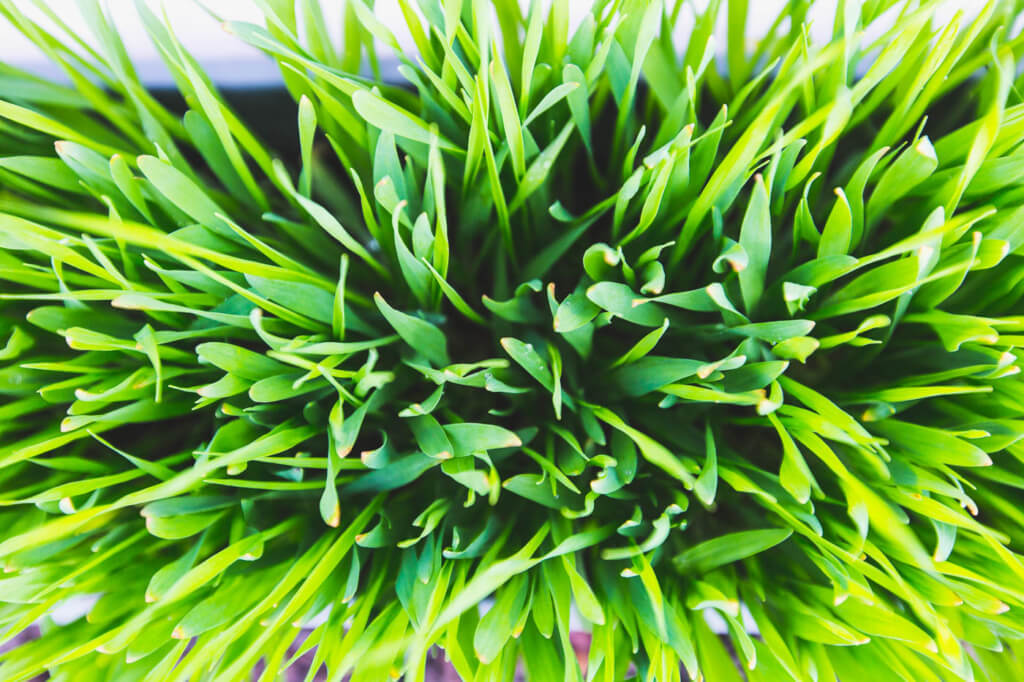
Plants use potassium in four very important ways:
Signaling
Because it’s simple, soluble, and charged, potassium is an important signaling ion. This means that plants use potassium to communicate with the different cells and parts of the plant, coordinating growth and reproduction and mounting defenses to diseases and pests. Thus, potassium-deficient plants are more susceptible to pests.
Water movement
Potassium is also a simple and effective ion to control the osmotic potential of plant cells. Basically, the plant uses tiny pumps to move potassium from one area to the next in order to “inflate” certain cells with water. Water moves from the cells with low potassium concentrations to the cells with higher concentrations. This allows the plant to keep its tissues full of water, which is important since plants are mostly made of water.
Stomata (gas exchange)
Potassium also allows the plant to do things like open tiny pores in the surface of the leaves (called stomata) to allow gas to enter and exit the plant.
Building proteins
Last but not least, potassium is important to building proteins, which are crucial to plant survival.
3) Potassium in fish feed is insufficient for both fish and plants
For fish, potassium is one of the top ten most important elements (by % of body weight). For this reason, fish feed usually contains quite a bit of potassium.
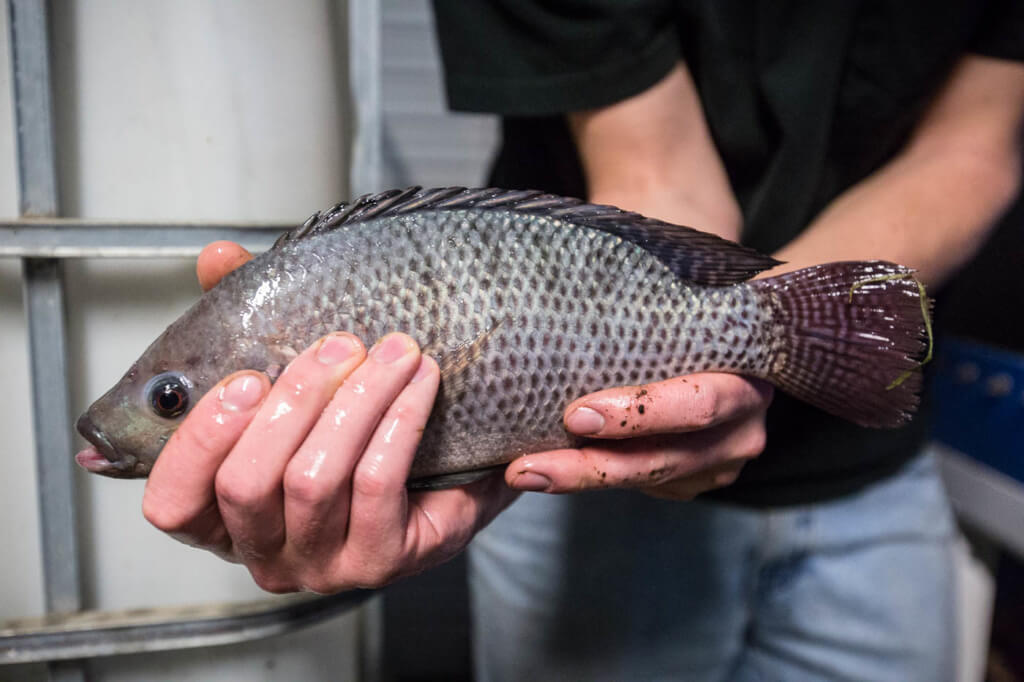
Unfortunately, the potassium in fish feed still isn’t enough for plants. Feed is formulated to be efficient, so it rarely includes more potassium than is necessary for the fish. This is because most fish feed isn’t made with aquaponics in mind, but aquaculture—where excess potassium would just go to waste. When traditional aquaculture feeds are used in aquaponics, there just isn’t enough potassium to go around.
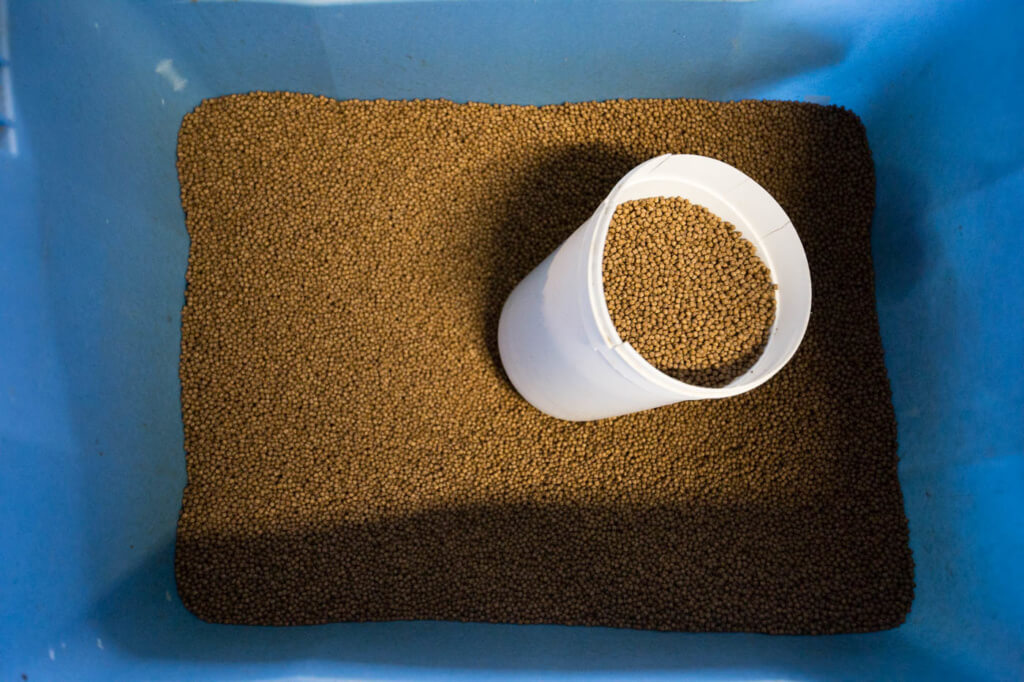
Plants, especially flowering and fruiting plants, consume potassium at rates significantly higher than rates of input. Potassium is almost always deficient in mature aquaponic systems. So in order to have healthy plants, you’ll have to artificially bump up the amount of potassium in your system with supplementation.
4) Supplementing potassium in system solution
You can supplement potassium one of two ways:
- by applying it foliarly (spraying it on the plant leaves) using potassium chloride
- by adding potassium to your system solution using potassium hydroxide, kelp meal concentrate, or potassium sulfate
The most common (and often easiest) way is to supplement the solution. In some cases, supplementing potassium in the solution can be problematic. This is because the amount of potassium you add to your system isn’t always what is available to your plants.
Why wouldn’t it be available? Well, potassium can interact with other elements in ways that we don’t expect. Namely, it interacts with calcium and magnesium, both of which reduce the availability of potassium to plants. This means that plants can show potassium deficiency symptoms even if there is technically plenty of potassium in the system.
Calcium is the ringleader of the “let’s complicate potassium uptake” club. Systems with lots of calcium (maybe they use calcium carbonate to “buffer” pH or maybe the input water is hard with calcium-based carbonates) reduce the ability of the plants to take up potassium.
The same is also true of magnesium but to a lesser extent.
The key to potassium management is balancing Ca, Mg, and K
Balancing calcium and magnesium is key to supplementing potassium effectively. We must make sure that we are not supplementing one at the expense of the others.
There are two ways to maintain a balance:
- Adding proper levels of potassium, calcium, and magnesium based on your system’s needs, and
- applying one, or all of these nutrients foliarly (essentially bypassing much of the issues with trying to balance nutrients in solution).
5) Identifying potassium deficiencies
Potassium deficiencies can be difficult to diagnose, primarily because they resemble in many aspects, deficiencies in Calcium and Magnesium. There are some distinguishing features, however.
The marks of a potassium deficiency
Potassium deficiencies will show up initially as interveinal chlorosis (when the space between the plant veins yellow, but the veins stay green), starting in the older growth. This is because potassium is mobile in the plant, allowing the plant to reallocate what potassium it has from the old growth to the new, delicate growth.
If the potassium deficiency isn’t initially treated, it will get worse, culminating in browning, drying, and death of the edges of the leaves. In addition, you will find dead, necrotic spots on the leaves, as well as bronzing and cupping.
Each crop can show slightly different symptoms, and often, when the deficiency becomes extreme, it becomes impossible to differentiate from calcium deficiency.
O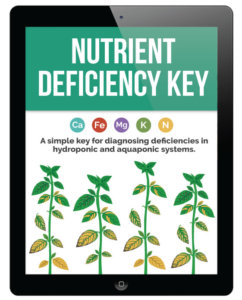 ne telltale sign for many crops in aquaponic systems is the stunting of root growth. This means that plants show slowed or stunted growth and can be easily pulled from the media. The root system of pulled plants will be small, often browned, and lack lots of structure.
ne telltale sign for many crops in aquaponic systems is the stunting of root growth. This means that plants show slowed or stunted growth and can be easily pulled from the media. The root system of pulled plants will be small, often browned, and lack lots of structure.
To help with diagnosis, please download the Nutrient Deficiency Key developed by Dr. Nate Storey. It isn’t foolproof, but it can give you a starting point for diagnosing potassium, calcium, magnesium and iron deficiencies, and help you to see the differences between them.
6) Correcting and managing deficiencies in the long-term
When it comes to managing nutrients with frequent deficiency, the best thing that a manager can do is to proactively solve the problem, instead of waiting for the problem to manifest. Managers can create a supplementation calendar to avoid deficiencies.
Depending on your actual pH range and your desired pH range, there are a number of ways to supplement potassium.
Low pH systems: potassium hydroxide (caustic lye)
“For low pH systems, the best potassium supplement is potassium hydroxide (caustic lye). This is a great way to supplement potassium while raising your pH. Potassium hydroxide is very strong base, meaning that is is an excellent way to raise pH. Potassium carbonate can also be used but is a carbonate, so it’s not appropriate unless your system trends to pH values around 6.0 consistently.”
For high pH or neutral systems: kelp meal concentrates or potassium sulfate
“For pH neutral or basic systems, you want to add potassium in a form that will not impact your pH. Your best options in this regard are kelp meal concentrates or potassium sulfate.
Kelp meal concentrates are available in a liquid or powdered form. If you want the most bang for your buck, buy kelp concentrate in powdered form. Typically, 1–2 dry ounces of powder will make 1 gallon of concentrate, significantly bringing down the cost of using kelp concentrate in your system. It should be noted that kelp meal concentrate also delivers other micronutrients that can be beneficial to your system health and can be applied foliarly for faster results.”
I’m ready to deal with potassium in aquaponics—but what about other aquaponic questions?
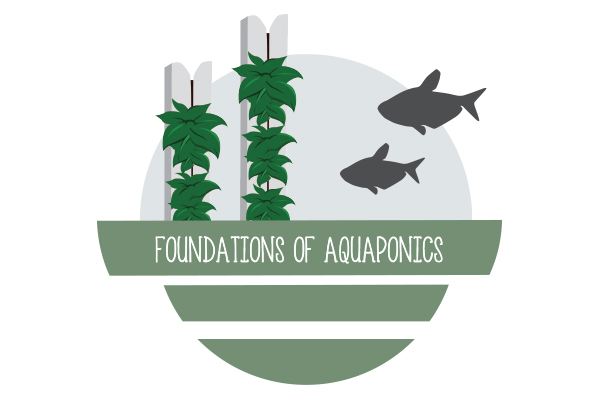 Managing an aquaponic system is a dynamic, interesting, and challenging task. Fortunately, we’re here to help you with any aquaponic question you might have, starting with a self-paced easy-to-learn course on aquaponics from Dr. Nate Storey.
Managing an aquaponic system is a dynamic, interesting, and challenging task. Fortunately, we’re here to help you with any aquaponic question you might have, starting with a self-paced easy-to-learn course on aquaponics from Dr. Nate Storey.
Delve into your aquaponic education with the Foundations of Aquaponics course here.
Not a member of Upstart University? Get registered today for only $9.99 a month

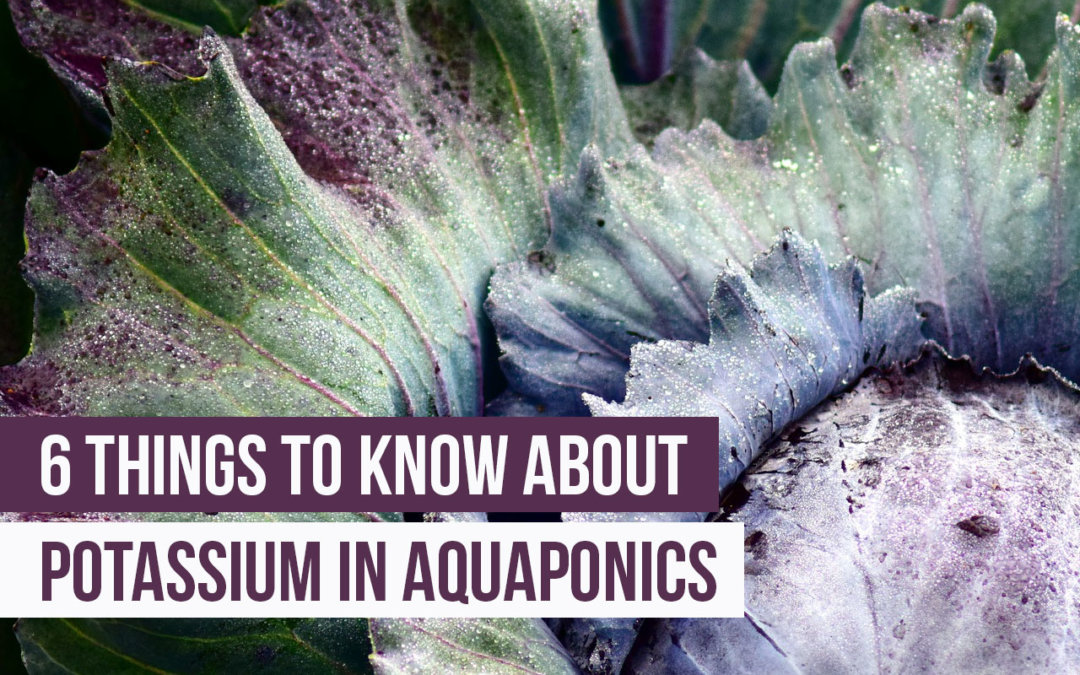

How often would you spray the plants with kelp solution?
Hi Shawn, that depends on the dilution. You can spray pretty often if it’s dilute. If you you’re spraying a more concentrated solution, once a week is about all you want to spray.
Hi , i have a question
my aquaponics system have 40 – 80 ppm nitrate.
I would like to grow 5000 head lettuce .
So with this rate can i grow it .
So 40 – 80 ppm nitrate
equal to what ratio in NPK . I mean N ratio .
If this rate cannot what
should i add in to my system .
Thank you
Hi Wong, your nitrates are in the correct range for an aquaponic system. You’ll know if you’re getting too low- your plants will show a deficiency.
Hello, a good Humic Acid can help?
Thank you
Hi Ricardo, Humic acid can help with algae control (it turns the water black, blocking out sunlight) but doesn’t do much for potassium. For potassium supplements, you’ll be better off using potassium hydroxide, kelp meal concentrate, or potassium sulfate.
I run my system at a PH of 6.2 what do you suggest for my system? Potassium that is.
Thank you
John
What brand of kelp meal concentrate do you use? The only product I’ve found has only < 1 K.
Thanks
Hi Pat, we use Kelp4Less. Be sure to grab the concentrate though, not just the kelp!
What’s the best way to add potassium organically?
Hey Dan, kelp meal concentrate is the best way to do this. Be sure to get the concentrate or “extract”, not plain kelp meal.
I read thay potassium carbonate can also be used is this correct?
hi
1. What are the recomended rate of N P K Ca Mg S in an aquaponic system for balance of nutrients and health of aquatic life, tilapia just now, later shrimps.
2. what are the maximum amounts of N P K Ca Mg S in an aquaponic system in therms of ppm?
3. in a more easy language, how many g/liter or oz/gal of what recommended nutrients can I add to an aquaponic system to max the ppms of N P K Ca Mg S
I went to the kelp4less webpage as you recommend them. they tell me to buy:
1. Azomite Powder
2. Fulvic Acid
3. Humic Acid
4. Kelp
5. SOP Powder
6. K Mag
what amounts of each one can I add to my aquaponic system to get to the recomended rates and ppms?
foliar?
Hi Homar, check out the aquaponic nutrients playlist – it describes how to supplement all of those nutrients. https://www.youtube.com/watch?v=Lgtue6tbbhc&list=PLAPahqrfGZZmLPh4vXzRDqWrXP7L9mnWT
I’m having a hard time managing potassium sulfate 0 – 0 – 50 and Epsom salts. I have 7000 liter system and my ph is 6.7 – 7.1. how much should I add of them so they are balanced?
hi. I have seen that video a lot of times! I have learn a lot from it. but, it still dont said how many grams or oz of each salt to add per gal of an aquaponic system
Excellent article. I use Potassium Bicarbonate in my aquaponics system. My pH tends to stay in the low 6 range, so this helps in raising the pH. I tend to add Potassium Bicarbonate to my system every 3-4 days.
Hi there
I’m using Gaia Green Kelp Meal powder (1-0-3 NPK) to supplement my system with potassium. I have no idea how much to add. Are there any general guidelines about how much to dilute into solution and then add to the system?
Cheers!
Jonathan
Hi Jonathan! There aren’t any rules of thumb for adding kelp because I don’t know what your potassium levels are currently. If you’re experiencing a deficiency it’s a little bit easier to feel it out by adding a little but until the deficiencies are taken care of. I will advise you to use kelp meal concentrate (sometimes called extract), not powder.
What about potassium nitrate
You could use potassium nitrate, but KOH or kelp meal would be better and less destabilizing.
Thank you so much Amy
How much per gallon
Whichever product you use, it should come with a dosing rate included.
Hello! If i want to apply potassium chloride foliarly, how much gallons/liters per gram should I use? Thanks!
Hi, can you apply potassium sulfate foliary, if not please explain why.
Hey Ramon, you can apply it foliarly, although you’ll want to use it sparingly that way and make sure to have great airflow.
We balance Ca, Mg, and K in a fairly large system (40,000gals) with unfiltered well water that is high in Ca and Mg. Would KOH still be an option if my pH is slowly and continuously dropping (currently 5.5-6.5) and I need to supplement high ppms of K to balance everything out? Also, what brands of KOH KCO do you use?
Can you tell me your recommended potassium, magnesium, and calcium parts per million and your ideal range for ph that won’t block any of those nutrients out? I’ve read the higher the ph the less available some of the nutrients. I do have equipment to test ppm. thank you.
I also along with many other would like an established ppm for all nutrients if possible. Thank you
In ppm, level of potassium in aquaponic.pls immediate answer from Nigeria
Hi Amos,
Potassium levels are variable depending on the levels of other nutrients in your system, especially calcium and magnesium.
Ppm per gallon pls
I have an idea. I have been thinking over it for sometime now but I’m not sure if it will work out. Here is it:
Instead of aquaponic or hydroponic, while dont we look for a source of protein, decompose it to produce ammonia eliminating the fish in the system. Supplementing ammonia to the system at a save level for only the plants and the bacteria from the decomposed organic matters like fly maggots for example. So we cut cost on fish feed. What do you guys think about my idea please. From Nigeria
And supplementing other nutrients needed in the system. Thanks
What i did is to check out the recommended level of nutrient in the soil in ppm and apply that to the system also then watch for deficiency of any kind.
I first want to say I Love what you are doing!
Q:what is your preferred mixing ratio for spraying potassium bicarbonate?
Louis—
The ratio should typically be listed on the product label, however, if it’s not, the rate is 5-20 grams/liter for 99% potassium bicarbonate.
Very pleased to find this source of info.
Can you supplement with mineral dust (rock dust)
Hi scott rumpel,
Yes, glacial or volcanic rock dust can be used. It is best to mix into the media if possible. Mixing into solution can lead to sediment which can potentially cause clogging in filters, pumps, emitters, etc.
Hi, I have about 460gallons and I have seen what I believe to be potassium deficiency in my tomato and other plants, can I use potassium bicarbonate, if so how much should I be adding and how often, thank u
Hi there Jc. You can use potassium bicarbonate to treat deficiencies, either as a solution addition or as a foliar spray. It’s acidic, so it will raise your pH, but carbonates can also buffer your pH and make it more difficult to manage. Our advice is to use potassium bicarbonate sparingly. As for mixing instructions, just follow the directions on the label and when in doubt, start with lower concentrations and observe the results before adding more.
Hello can you pls tell me at what ppm should we have potassium in our aquaponics systems.i have a potassium checker from hanna instruments. But have no idea what level we should run at .it very vague on the net .thanks Craig
Hi Craig—
Ppms for nutrients in both aquaponics and hydroponics are fairly vague on the internet because it depends on the type and size of your system and what types of crops you’re growing. As long as your plants are healthy, you should have enough potassium in your system. Shoot for around 40–70 ppm as a good general range, but remember that your system is unique and may have different needs.
Hi Craig,how did you get on with the hanna checker and is it the 100 ppm one.
I have been intouch with hanna many times asking for info about different testers but never get straight recommendations for their equipment.
Hi, can i use potassium phosphate for supplementing potassium? If yes, should i supplement it through the solution or foliar?
Cheers
Vignesh
Hi Vignesh,
Yes, but it will complicate your phosphate cycle if you put it in solution. I would do a foliar spray according to the listed foliar application rate on the fertilizer.
Hello, Can I use Potassium Carbonate or Potassium Bicarbonate through foliar application to supplement potassium and at the same time help with mildew? My water pH is 7.2 so I do not want to add it to the water and right now do not have Potassium Sulfate with me.
Hi Amar,
Potassium bicarbonate may suppress both downy and powdery mildew. Foliar uptake of potassium bicarbonate may occur, but you also risk the accumulation of salt deposits on leaf surfaces.
Hi
Is sea weed extract powder the same as kelp meal concentrate?
May I know what is better please?
How often do I have to add them to my fish tank on a rule of thumb.
Hi there—it should be the same.
I have a 2500 gallon system that is pretty new. It is cycled and running about 50 tilapia fingerlings at the moment. My Ph is very high at around 8.2 and I am working to get that down. In the meantime, I would like to try adding Iron (DTPA) and kelp powder to supplement the pale anemic plants. I understand you can’t tell me how much kelp powder to use but can you give me a ballpark figure to test trial? I have heard something like 1.4g/gallon of system water but that intuitively sounds excessive. There is no aquaponics specific dosing information on the package.
Hi..I’ve got to know that the required concentration of Ca is 40-70 ppm. Is it possible to run an aquaponic system at a higher concentration of Ca (let’s say 150 ppm)?
Hi there,
That will be fine as long as your pH is lower.
How to add iron in aquaponic and in which form so that it will not effect the fish
I have a 2,700 gallon (10220 liter) aquaponics system. Two fish tanks 530 gallons each, six media beds (hydroton), and a 940 gallon DWC. Two varieties of Tilapia, around 50 red and 50 blue Nile. I am growing a range of vegetables from leafy greens in the DWC to cucumbers, squash, tomatoes, and basil in the media beds. My water source is well water and on the hard side. My pH ranges between 6.8 and 7.8 but I try to keep it in the low 7’s. I add 270g of fe-DTPA chelated iron every three weeks, 1.5oz Magnesium Sulfate every 10 days and 300g soluble kelp powder every 20 days. My plant leaves, especially the squash seem to indicate a potassium deficiency. I would like to supplement the Potassium from the kelp with additional potassium in the form of potassium sulfate to the solution primarily because the kelp is quite expensive. I see you offered that 40–70 ppm potassium as a good general range. If my math is correct: 55ppm K2O x 10,220 system liters = 562,100 mg or 562g K2O. Using 50% Potassium Sulfate, add 1.1kg for 55ppm K20. This sounds like an excessive amount of Potassium?
hello,i have a small aquaponic system running about 272plants, tomato and bell peppers.
my bell pepper is fruiting but i think they need some potassium as a little boost.i have potassium hydroxide and i am thinking of applying it foliary as i am scared it may affect my catfish.What do you advice and how should the application be done.Thanks
i grow Barley Fodder in a container, in 7 days, just with water, can i use Potassium for that or do you offer me any other Fertilizer for that?
Can I apply urea for my planted aquarium tank? And what would be the ratio per gallon of water?hope your answer,thanks
Dear Ph.D,
I have just started my aquaponics system about a month but the plants does not grow and I have tested water I can see that the level of Nitrate is about 0.5 ppm and pH is 6.8.
My fish tank is about 6,600 litter with 250 tilapia. What should I do?
Thanks,
Dear Ph.D,
I have just started my aquaponics system about a month but the plants (only vegetable) does not grow and I have tested water I can see that the level of Nitrate is about 0.5 ppm and pH is 6.8.
My fish tank is about 6,600 liter with 250 tilapia. What should I do?
Thanks,
Hello all
Everyone is confused about how to add potassium which made me write this response
Here there should be two answer, one for hobbyist and the other for commercial production.
I will start with the hobbyist with simple language,
Green plants consume more potassium than nitrogen N, so if your system is running at 40ppm Nitrogen you need at least 50ppm Potassium and suppose fish food supplies 15ppm, then we need to add 35ppm every week, and you can divide this value in to 2-3 time per week. plant will store it and use it, K it is one of the transport elements inside the plant.
What you need to know to achieve this purpose is that:
Potassium Sulfate K2SO4 (0-0-50 NPK) it has 50% K2O that mean 41.5% of K element so every 1000g have 415g of K element.
Potassium Chloride KCl (0-0-63 NPK) it has 63% K2O that mean 52.3% of K element so every 1000g have 523g of K element.
Potassium hydroxide 90% KOH (0-0-84 NPK) it has 84% K2O that mean 69.7% of K element so every 1000g have 697g of K element.
so for 35ppm K you need 35 milligram of K element to every liter in your system (or 35g to 1000 liter)
About calcium , it is not mobile in plants like potassium, It is kept in the water and consumed slowly according to the needs of the plant (Green plant consume only 18-22% calcium ratio to K), In order to get this, a a little more calcium must be available in water, as the system also needs additional calcium to maintain ph good rang.
about commercial production:
There is no easy way, You have to calculate the volume of your production and the amount of elements K in it, in order to add it. (calculate the incoming and outgoing of the element K)
I wish you all a good day
I’m trying to run an aquaponics system… without fish (well, one fish). We have a 400 gallon system, three years old. We started with 50 tilapia and harvested (all but one) last year (the one remaining was an escapee we didn’t detect for months, that somehow survived on algae during that time). I supply 1-2 Tbsp of ammonium chloride every day. Nitrification occurs very quickly (as tested by ammonia, nitrite, and nitrate levels), dropping the pH by a full point. I also add potassium bicarbonate and potassium carbonate to keep the pH from getting too acidic. My calcium hardness is 110 ppm at last measure so I no longer add calcium carbonate. I add Fe DTPA, and just started adding a small amount of epsom salts. For the first year my plants were fine, but this year they are showing some nutrient deficiency symptoms… maybe potassium or magnesium.
Anyway, my question… am I headed towards a disaster? Is all the chloride building up? I couldn’t find any discussion of what I’m trying to do. There is a small amount of fish food and waste in the system as well from the one tilapia.
Am growing lettuce in 4000 gallons of water what’s my pH range should be and how much potassium should I add to the system..